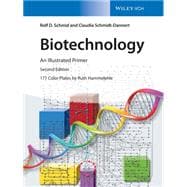
Note: Supplemental materials are not guaranteed with Rental or Used book purchases.
Purchase Benefits
What is included with this book?
Preface IX
Preface to the 2nd edition X
Introduction 1
Introduction
Early developments 2
Biotechnology today 4
Microbiology
Viruses 6
Bacteriophages 8
Microorganisms 10
Bacteria 12
Yeasts 14
Fungi 16
Algae 18
Some bacteria of importance for biotechnology 20
Microorganisms: isolation, preservation, safety 22
Microorganisms: strain improvement 24
Biochemistry
Biochemistry 26
Amino acids, peptides, proteins 28
Enzymes: structure, function, kinetics 30
Sugars, glycosides, oligo- and polysaccharides 32
Lipids, membranes, membrane proteins 34
Metabolism 36
Genetic engineering DNA: structure 38
DNA: function 40
RNA 42
Genetic engineering: general steps 44
Preparation of DNA 46
Other useful enzymes for DNA manipulation 48
PCR: general method 50
PCR: laboratory methods 52
DNA: synthesis and size determination 54
DNA sequencing 56
Transfer of foreign DNA in living cells (transformation) 58
Gene cloning and identification 60
Gene expression 62
Gene silencing 64
Epigenetics 66
Gene libraries and gene mapping 68
Genetic maps of prokaryotes 70
Genetic maps of eukaryotes 72
Metagenomics 74
Cell biology
Cell biology 76
Stem cells 78
Blood cells and immune system 80
Antibodies 82
Reporter groups 84
Solid state fermentation (SSF) 86
Growing microorganisms 88
Growth kinetics and product formation 90
Fed-batch, continuous and high cell density fermentation 92
Fermentation technology 94
Fermentation technology: scale-up 96
Cultivation of mammalian cells 98
Mammalian cell bioreactors 100
Enzyme and cell reactors 102
Recovery of bioproducts 104
Recovery of proteins: chromatography 106
Economic aspects of industrial processes 108
Food and food additives
Alcoholic beverages 110
Beer 112
Fermented food 114
Food and lactic acid fermentation 116
Prebiotics and probiotics 118
Bakers’ yeast and fodder yeasts 120
Fodder yeasts from petroleum feedstocks, single cell oil 122
Amino acids 124
l-Glutamic acid 126
d,l-Methionine, l-lysine, and l-threonine 128
Aspartame™, l-phenylalanine, and l-aspartic acid 130
Amino acids via enzymatic transformation 132
Vitamins 134
Nucleosides and nucleotides 136
Industrial products
Bio-Ethanol 138
1-Butanol 140
Higher alcohols and alkenes 142
Acetic acid / vinegar 144
Citric acid 146
Lactic acid, 3-hydroxy-propionic acid (3-HP) 148
Gluconic acid and “green” sugar chemicals 150
Dicarboxylic acids 152
Biopolymers: Polyesters 154
Biopolymers: Polyamides 156
Polysaccharides 158
Biosurfactants 160
Fatty acids and their esters 162
Enzyme technology
Biotransformation 164
Technical enzymes 166
Applied enzyme catalysis 168
Regio- and enantioselective enzymatic synthesis 170
Enzymes as processing aids 172
Detergent enzymes 174
Enzymes for starch hydrolysis 176
Enzymatic starch hydrolysis 178
Enzymes and sweeteners 180
Enzymes for the hydrolysis of cellulose and polyoses 182
Enzymes in pulp and paper processing 184
Pectinases 186
Enzymes and milk products 188
Enzymes in baking and meat processing 190
Other enzymes for food products and animal feed 192
Enzymes in leather and textile treatment 194
Procedures for obtaining novel technical enzymes 196
Protein design 198
Antibiotics
Antibiotics: occurrence, applications, mechanism of action 200
Antibiotics: screening, industrial production, and mechanism of action 202
Antibiotic resistance 204
β-Lactam antibiotics: structure, biosynthesis, and mechanism of action 206
β-Lactam antibiotics: manufacture 208
Amino acid and peptide antibiotics 210
Glycopeptide, lipopeptide, polyether, and nucleoside anti-biotics 212
Aminoglycoside antibiotics 214
Tetracyclines, chinones, chinolones, and other aromatic antibiotics 216
Macrolide antibiotics 218
New pathways to antibiotics 220
Pharmaceuticals and medical technology
Insulin 222
Growth hormone and other hormones 224
Hemoglobin, serum albumen, and lactoferrin 226
Blood clotting agents 228
Anticoagulants and thrombo-lytic agents 230
Enzyme inhibitors 232
Interferons 234
Interleukins and “anti-interleukins” 236
Erythropoietin and other growth factors 238
Other therapeutic proteins 240
Monoclonal and catalytic antibodies 242
Recombinant antibodies 244
Therapeutic antibodies 246
Vaccines 248
Recombinant vaccines 250
Steroid biotransformations 252
Diagnostic enzymes 254
Enzyme tests 256
Biosensors 258
Immunoanalysis 260
Glycobiology 262
Agriculture and environment
Animal breeding 264
Embryo transfer, cloned animals 266
Gene maps 268
Transgenic animals 270
Breeding, gene pharming and xenotransplantation 272
Plant breeding 274
Plant tissue surface culture 276
Plant cell suspension culture 278
Transgenic plants: methods 280
Transgenic plants: resistance 282
Transgenic plants: products 284
Aerobic wastewater treatment 286
Anaerobic wastewater and sludge treatment 288
Biological treatment of exhaust air 290
Biological soil treatment 292
Microbial leaching, biofilms, and biocorrosion 294
Megatrends
The human genome 296
Functional analysis of the human genome 298
Pharmacogenomics, nutrigenomics 300
DNA assays 302
Gene therapy 304
Induced pluripotent stem cells (iPS) 306
Tissue Engineering 308
Drug screening 310
High-throughput sequencing 312
Proteomics 314
DNA and protein arrays 316
Metabolic engineering 318
Synthetic biology 320
Systems biology 322
Bioinformatics: sequence and structural databases 324
Bioinformatics: functional analyses 326
Carbon sources (C-sources) 328
Biorefineries 330
Safety in genetic engineering 332
Regulation of products derived from biotechnology 334
Ethical considerations and acceptance 336
Patents in biotechnology 338
International aspects of biotechnology 340
Further Reading 343
Index 376
Picture Credits 398
The New copy of this book will include any supplemental materials advertised. Please check the title of the book to determine if it should include any access cards, study guides, lab manuals, CDs, etc.
The Used, Rental and eBook copies of this book are not guaranteed to include any supplemental materials. Typically, only the book itself is included. This is true even if the title states it includes any access cards, study guides, lab manuals, CDs, etc.